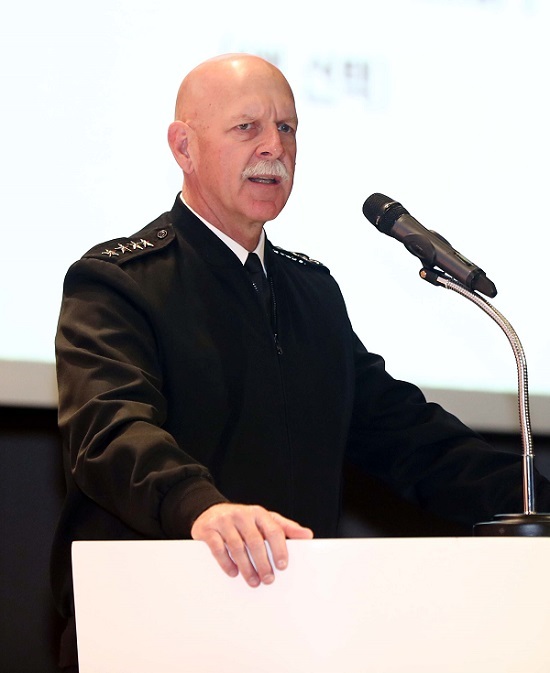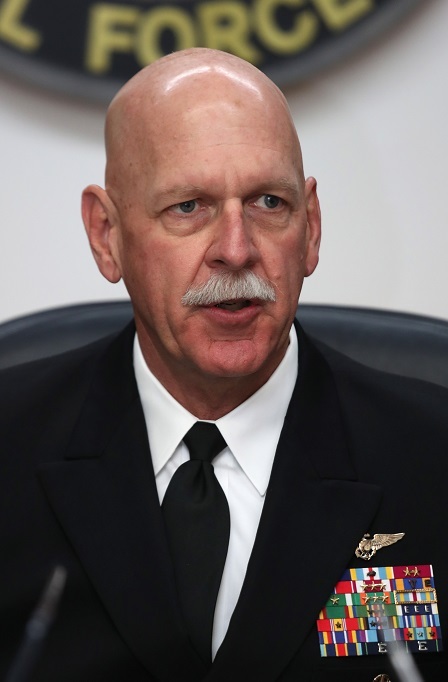Despite North Korea’s accelerating efforts, Pyongyang is still “years away” from mastering the submarine-based ballistic missile technology, a top US Navy official said Tuesday, calling for greater attention on the communist country‘s progress on land-based ballistic missiles and warhead miniaturization development.
Adm. Scott Swift, commander of the US Pacific Fleet also expressed skepticism toward additional deployment of US strategic assets to the Korean Peninsula, although he did not rule out the possibility for such a measure should North Korea’s military threats evolves further.
 |
Adm. Scott Swift, commander of the US Pacific Fleet (Yonhap) |
Pyongyang has been spurring its SLBM development since the regime successfully test-fired the missile in August. But controversy has persisted over the North’s ability to deploy an SLBM-enabled submarine to battle lines.
“To launch the missiles under the water is very, very complicated. I think it is still years away before that technology is developed,” Swift said during an interview with The Korea Herald and other news outlets at the US Naval Forces Korea command in Seoul.
“It’s more important to focus on the general ballistic missile capability that North Korea is developing,” said the admiral, referring to Pyongyang’s latest launch of medium-range ballistic missiles that used SLBM technology and solid fuel technology.
The admiral was in Seoul as part of a three-day trip to South Korea. On Tuesday, he attended an international forum to discuss amphibious operation in the Asia-Pacific region and met with South Korea’s military leadership, including Gen. Lee Sun-jin, chairman of South Korea’s Joint Chiefs of Staff.
Despite speculation the North has inched closer to completing SLBM technology, he stressed that Pyongyang has yet to secure key elements crucial for a successful launch: the missile technology and the miniaturization of nuclear weapons.
“There are two broad elements to focus on. One is missile technology itself: both the physics of developing the missile and its reliability as well as accuracy of the missile. The other element is miniaturization of nuclear capability.”
Confronted with North Korea’s evolving nuclear and missile threat, the commander has been expanding the role of the 3rd Fleet by forward deploying its strategic assets to the 7th fleet, whose area of operation mostly encompasses South Korea, Japan and China.
Last month, nuclear-powered aircraft carrier USS Carl Vinson was deployed to the Korean Peninsula after departing San Diego, where the headquarters of the 3rd Fleet is located. After entering the 7th Fleet area of operation, The Nimitz-class aircraft carrier remains under the 3rd Fleet’s command and control.
But the admiral said although the US Navy will continue to expand its involvement in the Asian-Pacific region, there would be no additional “forward deployment” of US aircraft carriers and other strategic assets to the Korean Peninsula.
 |
Adm. Scott Swift, commander of the US Pacific Fleet (Yonhap) |
“One of the great advantages of naval power is its flexibility to deploy, but I don‘t see any additional carriers being forward deployed. ... The challenge we have is the facility for maintaining and sustaining our ships.”
“We will reach 60 percent of naval forces present in the Pacific by 2020. And all those decisions have been made and investments have been made. It‘s probably 57 or 58 percent. But it fluctuates from day to day.”
When asked about whether the US Navy would dispatch its stealthy destroyer Zumwalt -- an idea reportedly floated by Adm. Harry Harris, commander of the US Pacific Command, during a meeting with South Korean lawmakers, Adm. Swift expressed skepticism, but added “anything is possible.’
“Anything is possible. We can have the entire US Navy move somewhere. But it is very, very premature to discuss the probability of that. I would not recommend forward deploying it until we have fully have worked through challenges,” he said.
By Yeo Jun-suk (
jasonyeo@heraldcorp.com)







![[Herald Interview] 'Trump will use tariffs as first line of defense for American manufacturing'](http://res.heraldm.com/phpwas/restmb_idxmake.php?idx=644&simg=/content/image/2024/11/26/20241126050017_0.jpg)
![[Health and care] Getting cancer young: Why cancer isn’t just an older person’s battle](http://res.heraldm.com/phpwas/restmb_idxmake.php?idx=644&simg=/content/image/2024/11/26/20241126050043_0.jpg)
